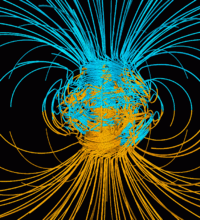| Names | TRACERS |
|---|---|
| Mission type | Heliophysics |
| Operator | NASA |
| Website | tracers |
| Spacecraft properties | |
| Spacecraft | TRACERS |
| Spacecraft type | Orbiters (2) |
| Manufacturer | Millennium Space Systems |
| Start of mission | |
| Launch date | April 2025 (planned) |
| Rocket | Falcon 9 Block 5 |
| Contractor | SpaceX |
| Orbital parameters | |
| Reference system | Geocentric orbit |
| Regime | Low Earth orbit Polar |
| Altitude | 600 km |
 TRACERS logo Small Explorer program (SMEX)← SMEX 16SMEX 17 → | |
Tandem Reconnection and Cusp Electrodynamics Reconnaissance Satellites (TRACERS) is a planned orbiter mission tasked to study the origins of the solar wind and how it affects Earth. TRACERS was proposed by Craig A. Kletzing at the University of Iowa who served as Principal Investigator until his death in 2023. David M. Miles at the University of Iowa was named as Principal Investigator in his stead. The TRACERS mission received US$115 million in funding from NASA.
Overview

TRACERS is a future mission by NASA that aims to answer long-standing questions critical to understanding the Sun-Earth System. TRACERS is a pair of identically instrumented spinning spacecraft that will study how the Sun's solar wind interacts with the Earth's magnetosphere. TRACERS was initially planned to be launched as a secondary mission to another orbiter named Polarimeter to Unify the Corona and Heliosphere (PUNCH). PUNCH will study the solar wind, a stream of charged particles emanating from the Sun, while TRACERS will study Earth's response.
TRACERS will observe solar particles interacting with Earth's magnetic field at the northern magnetic cusp region. Here, the field lines guide particles from the boundary between Earth's magnetic field down into the atmosphere. In a process known as magnetic reconnection, the field lines violently reconfigure, sending particles out at speeds that can approach the speed of light. Some of these particles will be guided by the Earth's field into the region where TRACERS can observe them. TRACERS will study a longstanding question about where reconnection happens at the magnetopause and how the solar wind affects the place and timing, helping NASA better forecast the influx of energetic particles into Earth's magnetic field that has the potential to disrupt the power grid and satellite communications. TRACERS and PUNCH will work well together with the other existing heliophysics spacecraft.
On 20 June 2019, NASA announced that PUNCH and TRACERS were the winning candidates to become the next missions in the agency's Small Explorer program. On 29 September 2023 NASA Launch Services Program selected SpaceX's Falcon 9 rocket to provide the launch service for TRACERS launch through the Venture-Class Acquisition of Dedicated and Rideshare (VADR) program.
As of October 2023, TRACERS has a target launch readiness date of 13 April 2025.
Instruments
- DC Magnetometer (MAG) a fluxgate magnetometer that provides measurements of the background magnetic field up to 5 Hz will be provided by University of California, Los Angeles.
- A Search coil magnetometer (MSC) three-axis magnetic search coil to measure AC magnetic field from 2 Hz up to 1 kHz will be provided by University of Iowa.
- An Electric Field Instrument (EFI) a two axis electric field experiment to measure electric fields from 1 Hz to 1 kHz.will be provided by University of California, Berkeley.
- Analyzer for Cusp Electrons (ACE) an electrostatic analyzer to measure cusp electrons from 40 eV to 10 keV will be provided by University of Iowa.
- Analyzer for Cusp Ions (ACI) is an electrostatic analyzer to measure cusp ions from 50 eV to 10 keV.
A technology demonstration, Magnetometers for Innovation and Capability (MAGIC), was added in 2020 with the goal to test prototype magnetic-field instruments.
See also
References
- ^ NASA selects missions to observe the sun and its impact on Earth, Stephen Clark, Spaceflight Now, 26 June 2019
- Foust, Jeff (30 September 2023). "NASA selects SpaceX for rideshare launch of smallsat mission". SpaceNews. Retrieved 1 October 2023.
- Four Berkeley satellites could be exploring Mars and Earth by 2022. By Robert Sanders, Berkeley News, 9 July 2019.
- "Renowned Iowa physics professor, researcher Craig Kletzing dies | Physics and Astronomy - The University of Iowa". physics.uiowa.edu. Retrieved 2 October 2023.
- "Miles Named PI of TRACERS Mission | Physics and Astronomy - The University of Iowa". physics.uiowa.edu. Retrieved 2 October 2023.
- ^ Allen, Molly (24 June 2020). "UI-led space mission funded by $115 million grant from NASA takes next step". The Daily Iowan. Retrieved 3 May 2021.
- ^ NASA Selects Missions to Study Our Sun, Its Effects on Space Weather, NASA Press Release, 20 June 2019
- Frazier, Sarah (27 July 2021). "NASA's PUNCH Mission to Study the Sun's Environment Moves Toward Launch". NASA. Retrieved 28 July 2021.
- Dooren, Jennifer M. (29 September 2023). "NASA Announces Launch Services for Pair of Space Weather Satellites". NASA. Retrieved 5 October 2023.
- "TRACERS". University of Iowa. Retrieved 1 October 2023.
External links
| Solar space missions | |
|---|---|
| Current |
|
| Past |
|
| Planned |
|
| Proposed | |
| Cancelled | |
| Lost | |
| Sun-Earth | |
| Magnetospherics | |
|---|---|
| Submagnetosphere | |
| Earth's magnetosphere | |
| Solar wind | |
| Satellites |
|
| Research projects | |
| Other magnetospheres | |
| Related topics | |
| Future spaceflights | |||||||||||
|---|---|---|---|---|---|---|---|---|---|---|---|
| Crewed |
| ||||||||||
| Uncrewed |
| ||||||||||
| Recently launched |
| ||||||||||
